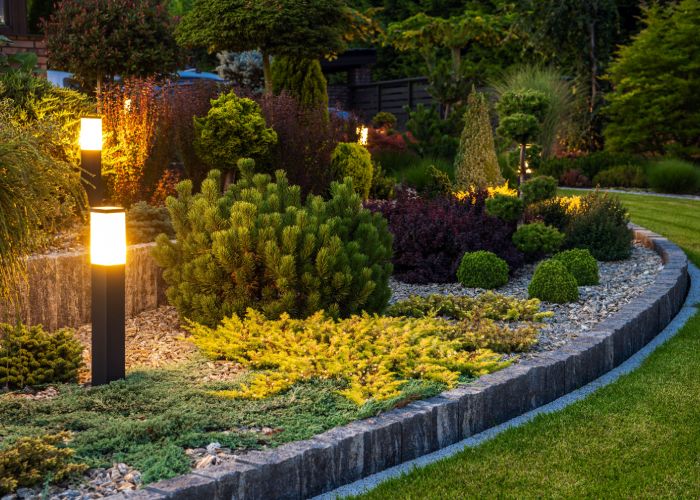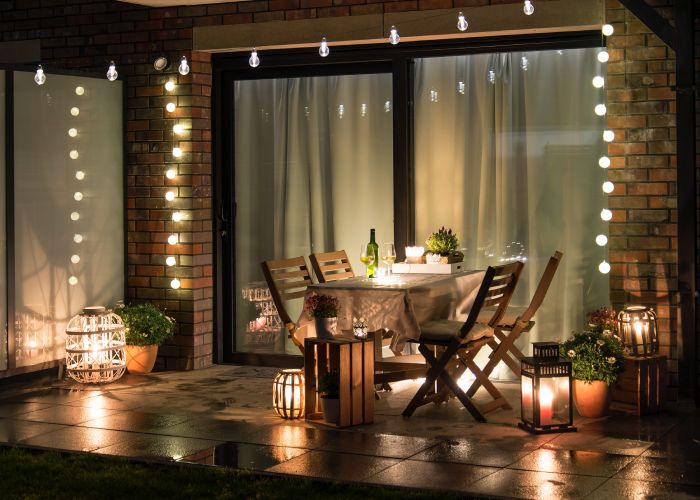Landscape design is an important aspect of any home. It adds not only beauty but also functionality to your outdoor space. One key element in landscape design is lighting, which can enhance the overall ambience and make your garden or yard more inviting.
In this article, we’ll discuss some essential tips and design inspirations for landscape lighting to help you achieve a stunning outdoor space.

Benefits of Landscape Lighting
Before delving into the tips and designs, it’s important to understand the benefits of landscape lighting. Here are some reasons why investing in landscape lighting is a smart choice:
- Safety: Properly lit pathways, stairs, and uneven surfaces can prevent accidents and injuries after dark by improving visibility.
- Security: A well-lit landscape can deter potential intruders by eliminating dark areas that could hide unexpected visitors.
- Extended Outdoor Use: Landscape lighting allows you to enjoy your outdoor spaces, allowing for activities after sunset.
- Aesthetic Appeal: Thoughtful lighting can accentuate architectural features, highlight key landscaping elements, and create a warm ambience.
- Property Value: A beautifully lit landscape can increase your home’s curb appeal and potentially resale value.
- Atmosphere Creation: Different lighting techniques can set various moods, from festive to tranquil, tailored to the occasion or desired ambience.
Essential Tips for Landscape Lighting
Now that you understand the importance of landscape lighting, here are some essential tips to keep in mind as you plan your outdoor lighting:
- Stick to a Plan: Before purchasing and installing any lights, plan the areas you want to illuminate and the type of light fixtures needed.
- Consider Safety First: When placing lights in high-traffic areas, make sure they do not obstruct pathways or become a tripping hazard.
- Layer Your Lights: Use a combination of different types of lighting, such as path lights, spotlights, and accent lights, to create depth and visual interest.
- Use LED Lights: LED lights are energy-efficient and have a longer lifespan than traditional bulbs, making them a cost-effective choice for landscape lighting.
- Avoid Glare: Position lights in a way that prevents direct light from shining into people’s eyes or causing obtrusive shadows.
- Think About Maintenance: Choose fixtures and lighting systems that are easy to maintain, especially if they’ll be installed in hard-to-reach areas.
- Consider Light Pollution: Be mindful of your neighbours and the environment using low-voltage lighting, motion sensors, and timers to reduce light pollution.
Design Inspirations for Landscape Lighting
Now that you have an idea of how to approach landscape lighting, here are some design inspirations to spark your creativity:
- Pathway Lighting: Illuminate walkways with pathway lights or bollard lights to create a safe and welcoming path.
- Highlight Architectural Features: Use spotlights or well lights to highlight architectural features, such as columns, pillars, or unique exterior textures.
- Moonlighting: Strategically placed lights in trees can create a soft moonlit effect that adds an enchanting touch to your landscape.
- Water Feature Lighting: Using submersible or underwater LED lights, add drama to your water features, such as fountains or ponds.
- Shadow Play: Use light fixtures with interesting shapes and textures to create unique shadows on walls, fences, or the ground.
- Patio/Deck Lighting: Install string, lanterns, or pendant lights to illuminate your patio and deck for outdoor dining and entertaining.
- Focal Point Lighting: Use accent lights or uplights to highlight focal points, such as a statue, sculpture, or prised plant.
Professional vs. DIY Installation
When considering landscape lighting, homeowners often decide between professional installation and the DIY (do-it-yourself) approach. The choice between the two can significantly impact the ease of installation, the final product’s quality, and the lighting systems’ longevity.
Professional Installation
Opting for professional installation means you’ll benefit from the expertise of experienced landscape lighting designers and installers.
They can help you with complex designs, ensure that electrical systems are safely installed, and help problem-solve any unique challenges your landscape may present.
Professionals also typically offer warranties on their work and can provide high-quality, commercial-grade lighting fixtures that may not be available at retail stores. Find out more about professional installation by talking to professionals in your area.
DIY Installation
The DIY approach is often more cost-effective and allows homeowners the freedom to work at their own pace. This option can be more suitable for simple lighting setups or those with a good grasp of electrical systems and landscape design.
However, self-installation can be time-consuming and might not yield the same polished look or durability as a professional job.
Additionally, most retail landscape lighting kits are designed for ease of installation, but they may not offer the same level of customisation or quality as professional-grade equipment.
Conclusion
Landscape lighting creates an inviting, safe, and attractive outdoor space. Following these tips and design inspirations, you can achieve a beautifully lit landscape that enhances your property’s aesthetics, functionality, and value.
Whether you choose professional or DIY installation, carefully plan out your lighting design to get the most out of this essential aspect of outdoor living.
So, don’t hesitate to explore different types of lighting and techniques to create a unique and inviting atmosphere in your outdoor space. Happy lighting!





